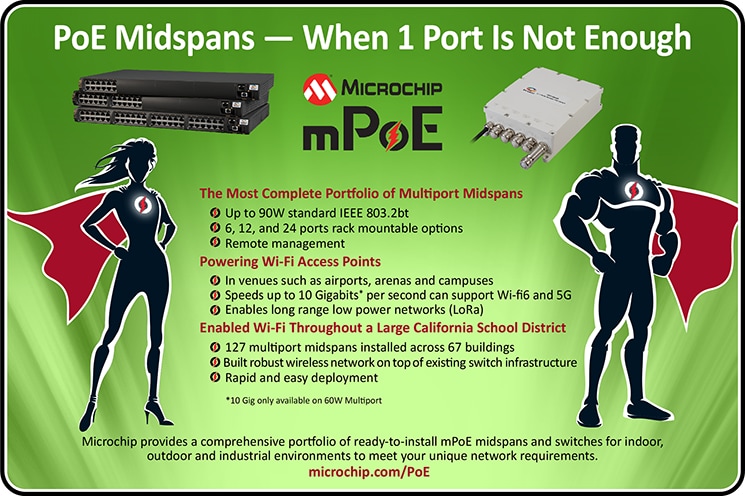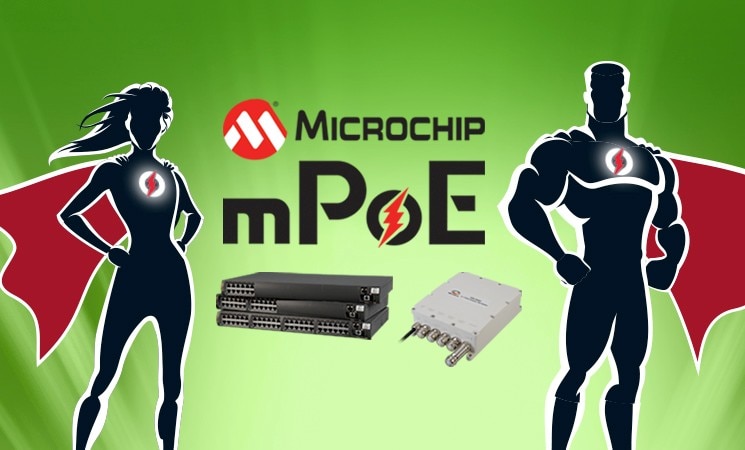PoE Midspans: When One Port is Not Enough
Single-port midspans are a highly effective solution although sometimes not the most efficient. When installing multiple devices such as WAPs throughout a campus, it is much more efficient to use a multiport midspan.
Power over Ethernet (PoE) Midspans
Power over Ethernet (PoE) has been available on networks since the late 1990s. Originally, most switches did not provide power, so Microchip Technology, the company who first introduced Power over Ethernet, stepped into the gap and built the first midspan. The midspan is inserted after the switch to add power onto the Ethernet cable.
Today there are many devices that can be run on PoE. Initially, PoE was used to power IP phones, cameras and Wireless Access Points (WAPs); however, there are many other devices enabled by PoE including security access points, controls such as thermostats, sensors, 5G small cells, LED lighting, Long Range Radio (LoRa) and even motorized shades. Every day, a new device is being introduced to take advantage of PoE because of its benefits.

Many manufacturers of these devices offer a “power” option of a single-port midspan. This enables them to offer an end-to-end solution including power if the device is being installed on a network that does not have power. Even for networks that do have power, there are limitations. Network switches have power budgets and frequently cannot offer full power on all ports, so a midspan is required to add supplemental power.
When to Use Multiport Midspans
Single-port midspans are a highly effective solution although sometimes not the most efficient. When installing multiple devices such as WAPs throughout a campus, it is much more efficient to use a multiport midspan. Microchip offers the broadest portfolio of multiport midspans in the market today to meet the needs of any situation. With a choice of IEEE® 802.3 af/at/bt-compliant devices, these multiport midspans can deliver from Class 1 4W up to Class 8 90W. With options of 6-, 12- and 24-port rack mountable midspans, customers can add power to existing switch infrastructures for an incremental investment or they can supplement power to PoE switches that are not capable of providing power on all ports due to power budget limitations. Because of the power management capabilities, scheduling, enabling, disabling and reassigning power to where it is needed is easy.
For today’s Wi-Fi® 6 demanding higher data rates, Microchip has the multiport, multi-gigabit solution supporting data rates of up to 10 gigabits per second. Microchip offers 6-, 12- and 24-port IEEE 802.3bt Type 3-compliant rack mountable midspans with web-based management capabilities to support Wi-Fi 6 data rate demands.
When deploying WAPs, a multiport midspan is usually the midspan of choice. One midspan, easily installed and connected to an existing switch mounted on the rack, can support up to 24 WAPs in a building, terminal, arena or campus. The flexibility offered by PoE's cable length of up to 100 meters, combined with the fact that Ethernet cables can be installed without a conduit and do not require an electrician, significantly speeds up installation and reduces costs.
That is why a leading system integrator who specializes in providing government entities with security technology options chose Microchip’s multiport midspans to deploy Wi-Fi throughout one of the largest school districts in California. Using Microchip 6-port and 12-port 60W midspans, the system integrator was able to deploy a robust wireless network over an existing structure across 67 buildings covering 320 square miles.
In the hands of professionals, the clear choice is the multiport. Installing one multiport unit that can support up to 24 devices per midspan with remote management greatly simplifies the installation of a large number of WAPs, IP cameras or IP phones.
Finally, as we look to smarter buildings in the future, PoE devices such as security access points, digital signage, climate sensors and controls, lighting sensors and controls, LED lighting, motorized shades, motion detectors, security cameras and Wi-Fi Access Points all need to be interconnected. Microchip PoE multiport midspans can provide or supplement the power needed to drive these devices. One midspan can support and manage multiple integrated devices to optimize the environment.
Visit our web page to learn more about Microchip multiport midspans.
